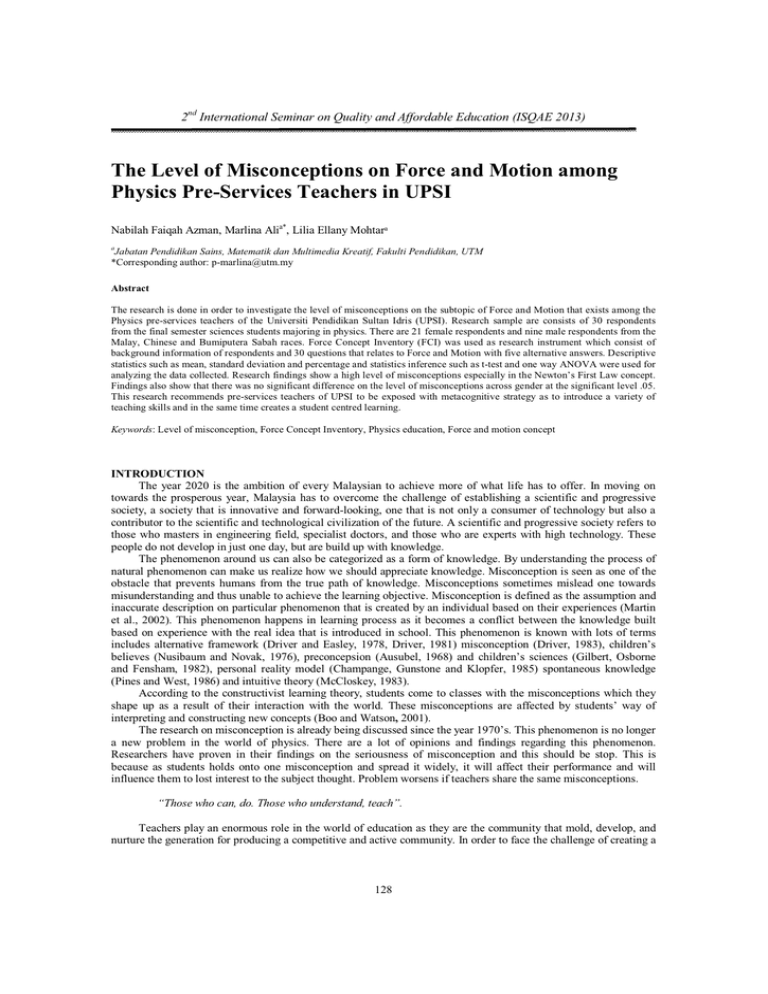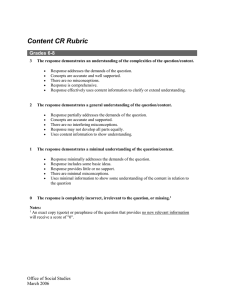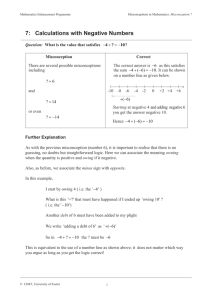The Level of Misconceptions on Force and Motion among Physics
advertisement

2nd International Seminar on Quality and Affordable Education (ISQAE 2013) The Level of Misconceptions on Force and Motion among Physics Pre-Services Teachers in UPSI Nabilah Faiqah Azman, Marlina Alia*, Lilia Ellany Mohtarᵃ a Jabatan Pendidikan Sains, Matematik dan Multimedia Kreatif, Fakulti Pendidikan, UTM *Corresponding author: p-marlina@utm.my Abstract The research is done in order to investigate the level of misconceptions on the subtopic of Force and Motion that exists among the Physics pre-services teachers of the Universiti Pendidikan Sultan Idris (UPSI). Research sample are consists of 30 respondents from the final semester sciences students majoring in physics. There are 21 female respondents and nine male respondents from the Malay, Chinese and Bumiputera Sabah races. Force Concept Inventory (FCI) was used as research instrument which consist of background information of respondents and 30 questions that relates to Force and Motion with five alternative answers. Descriptive statistics such as mean, standard deviation and percentage and statistics inference such as t-test and one way ANOVA were used for analyzing the data collected. Research findings show a high level of misconceptions especially in the Newton’s First Law concept. Findings also show that there was no significant difference on the level of misconceptions across gender at the significant level .05. This research recommends pre-services teachers of UPSI to be exposed with metacognitive strategy as to introduce a variety of teaching skills and in the same time creates a student centred learning. Keywords: Level of misconception, Force Concept Inventory, Physics education, Force and motion concept INTRODUCTION The year 2020 is the ambition of every Malaysian to achieve more of what life has to offer. In moving on towards the prosperous year, Malaysia has to overcome the challenge of establishing a scientific and progressive society, a society that is innovative and forward-looking, one that is not only a consumer of technology but also a contributor to the scientific and technological civilization of the future. A scientific and progressive society refers to those who masters in engineering field, specialist doctors, and those who are experts with high technology. These people do not develop in just one day, but are build up with knowledge. The phenomenon around us can also be categorized as a form of knowledge. By understanding the process of natural phenomenon can make us realize how we should appreciate knowledge. Misconception is seen as one of the obstacle that prevents humans from the true path of knowledge. Misconceptions sometimes mislead one towards misunderstanding and thus unable to achieve the learning objective. Misconception is defined as the assumption and inaccurate description on particular phenomenon that is created by an individual based on their experiences (Martin et al., 2002). This phenomenon happens in learning process as it becomes a conflict between the knowledge built based on experience with the real idea that is introduced in school. This phenomenon is known with lots of terms includes alternative framework (Driver and Easley, 1978, Driver, 1981) misconception (Driver, 1983), children’s believes (Nusibaum and Novak, 1976), preconcepsion (Ausubel, 1968) and children’s sciences (Gilbert, Osborne and Fensham, 1982), personal reality model (Champange, Gunstone and Klopfer, 1985) spontaneous knowledge (Pines and West, 1986) and intuitive theory (McCloskey, 1983). According to the constructivist learning theory, students come to classes with the misconceptions which they shape up as a result of their interaction with the world. These misconceptions are affected by students’ way of interpreting and constructing new concepts (Boo and Watson, 2001). The research on misconception is already being discussed since the year 1970’s. This phenomenon is no longer a new problem in the world of physics. There are a lot of opinions and findings regarding this phenomenon. Researchers have proven in their findings on the seriousness of misconception and this should be stop. This is because as students holds onto one misconception and spread it widely, it will affect their performance and will influence them to lost interest to the subject thought. Problem worsens if teachers share the same misconceptions. “Those who can, do. Those who understand, teach”. Teachers play an enormous role in the world of education as they are the community that mold, develop, and nurture the generation for producing a competitive and active community. In order to face the challenge of creating a 128 2nd International Seminar on Quality and Affordable Education (ISQAE 2013) scientific and progressive society, teachers should first master the knowledge beforehand as it will help them to be confident during the teaching and learning (T & L) process and set up a student centered learning. The pre-idea that being hold by students are firm and not easily changeable although scientific concept has been provided (Tsai, 1999; Sencar & Eryilmaz, 2004). This statement highlights teachers’ role of detecting the misconceptions that exist among students and take precaution steps and alternatives in order to curb the phenomenon of misconceptions. Therefore, it is very important for a pre service teacher not to have any misconceptions as is it will be inherited by their students. Therefore, the researcher believes that one study should be conducted to identify the misconception among pre service teacher. BACKGROUND OF PROBLEM The existence of the misconceptions phenomenon among pre-services teachers are mostly influenced by a few aspects such as: Lack of Understanding, Physics is Abstract and Examination Oriented Culture. Lack of Understanding A research by Erdal Tartal (2011a) on the misconception on states of matter, found out that participants’ misconceptions exits due to the lack of understanding. Erdal (2011b) adds that one of the causes of misconceptions in students is that the students inherit teachers (primary school teachers) with misconception. Teachers are the source of knowledge they said. Therefore, teachers should pay concern with their knowledge as to curb misconception among their students. A research findings conducted by H.C. Hill, B. Rowan and D. L. Ball (2000a) among mathematics teacher found that the knowledge of the mathematics teaches were significantly related to the achievements of the students whom they taught. Physics is Abstract Referring to Ministry of Education (2004), the ratio of students who select for science stream to the art stream is 22:78 in 1993. This fact has brought an impact as the challenge in upgrading Malaysia to become an industrialized country may be jeopardize as the deficient in number of scientific and technical human resources (Nurul-Awanis, A.W., Hazlina, A. H., Yoke-May, et al.,2011). Introducing Science at an early age is one of the ways to develop and promotes interest and understanding in students. As one have a firm grip of the basic concept at an early age, it will help to eliminate the stereotype that labeled Physics as abstract, meaning too difficult. Abstract is not something that can be imagining spontaneously. Based on Abdul Rahman and Zakaria (1994) research, students cannot understand abstract ideas that cross their limited experiences, which will end up OBJECTIVES AND RESEARCH QUESTIONS In order to answer the problem statement, researcher had developed a few research objectives which are to determine: a) the level of misconceptions on Force and Motion among Physics pre-services teachers and b) the level of misconceptions on Force and Motion among Physics pre-services teachers across gender. The research questions built from this research are as follows: a) What is the level of misconceptions on Force and Motion among Physics pre-services teachers? b) “Is there any significant differences on the subtopic Force and Motion among Physics pre-services teachers across gender?” METHODOLOGY This research is a quantitative descriptive research. Research were done in Universiti Pendidikan Sultan Idris (UPSI) where 30 respondents which includes 21 female and nine male from the final year students majoring in Physics. There are Malay, Chinese and other races participated in this research. In determine the level of misconceptions on the Force and Motion subtopic, a published inventory known as Force Concept Inventory (FCI) by Hestenes, Wells, & Swackhamer (1992) was used. The reliability of his inventory is 0.8. The inventory is divided into two sections which are the background information of respondents and 30 questions with multiple choices of answers. The Force Concept Inventory (FCI) is divided into six Newtonian concepts which are kinematics, Newton’s first law, Newton’s second law, Newton’s third law, superposition principle and kinds or force. The marking scheme made for the correct answers are one marks, and for incorrect answers zero marks are given. Next, the percentage of misconception for every subtopics of the Newtonian concept were obtained by dividing the marks of the incorrect answers with the total marks of each subtopic. Each subtopic has different values of full mark. The percentage of misconceptions for each subtopic were compared to the Misconception Division Level Table (refer to table 1). All data collected were analyzed using SPSS software. Data collected was analyzed descriptively and were presented in 129 2nd International Seminar on Quality and Affordable Education (ISQAE 2013) mean, standard deviation and percentage. Statistics inference analyze were also used by using the t-test in obtaining whether there is any differences among Physics pre-service teachers on subtopic of Force across gender. Percentage 85 – 100 70 – 84 55 – 69 40 – 54 0 – 39 Table 1: Misconception Division Level Table Level of Misconception Very high High Moderate Low Very low RESEARCH PROCEDURE Firstly, within the first and second week of the new semester of 2013, researcher will obtained the Selfdeclaration Letter and Authorization Letter from the Faculty of Education, UTM. After receiving the Self-declaration Letter and Authorization Letter from the Faculty of Education, a copy of the letter were send to the authority of the Universiti Pendidikan Sultan Idris (UPSI) for having the permission of performing a research among the physics education students. Then, the Force Concept Inventory used in obtaining the result of research, were distributed among the respondents on the following week after receiving the permission on performing the research. A date was arranged and a small meeting between researcher and respondents were made. Instruction of performing the inventory was given among all 30 respondents. As the inventory is the research instrument for assessing the concept of the Force and Motion subtopic, respondents were reminded not to discuss among themselves, inventories were collected and all 30 respondents were given a souvenir each as a symbol of gratitude. After that, the processes of marking the inventory were done on the week 3 until week 5. Next, data collected were inserted in the Statistical Package for Social Science (SPSS) software in the week of 4 and 5. Afterwards, the collected data were analyzed and presented descriptively in the form of percentage, mean and standard deviation. Then, by week 8 the result of inventory were fully reported regarding the findings of the misconception among preservice teachers. The figure 3.2 following is the summary of the research procedure. RESULTS AND DISCUSSION Based on the Table 2, the overall level of misconception among pre-service teachers on the subtopic of Force and motion is high (74.39 %). In this research, the highest levels of misconception are the subtopic of First Law (86.19 %), Superposition (83.33 %) and Kinematics (80.56 %). At the moderate level of misconceptions the subtopic are the Second Law (65.00 %), the Forces of Fluid Contact (65.00 %) and Third Law (69.17 %). The level of misconceptions among the pre services teacher shows the highest percentage on the topic of Newton’s First Law. Newton’s First Law states that if there is no force acting on a body, its state of motion will be unchanged. Many got uncertain about the definition and holds on common mistake by understanding that “if no net force acts on an object, the object must be at rest”. Relating to this confusion, commonsense thinkers come out with two kinds of force, which known as impetus and active force. ‘Impetus’ was introduced back in the pre-Galilean times, which refers to "motive power" or "intrinsic force" that keeps things moving. This commonsense is totally disagreed with Newton’s First Law. Table 2: The Level of Misconceptions among Physics Pre-Service Teachers on The Subtopic of Force and Motion. Concept Kinematics -Discrimination of position, velocity acceleration -Constant acceleration -Vector addition of velocities Newton’s First Law -With no force -With canceling forces Newton’s Second Law -Impulsive force -constant force implies constant acceleration Newton’s Third Law -For impulsive force Mean Standard Deviation 4.83 0.95 6.03 1.30 2.60 1.22 2.77 0.68 130 Percentage (%) 80.56 86.19 65.00 69.17 Level of Misconceptions High Very High Moderate Moderate 2nd International Seminar on Quality and Affordable Education (ISQAE 2013) -For continuous force Superposition -For impulsive force -For continuous force Kinds of force -Solid contact: passive, impulsive, friction opposing motion -Fluid contact: air resistance, buoyant -Gravitation: acceleration independent of weight -Parabolic trajectory Total 2.50 0.86 3.03 0.89 1.30 0.65 7.00 1.29 30.06 7.84 83.33 High 75.83 High 65.00 Moderate 70.00 High 74.39 High Impetus theory, describes about the force that acts on an object. As a force acts on an object, the object gains a property called impetus. Although the force is not in contact with the object, the impetus remains in the object and keeps the object moving. As time passes, impetus decreases because of the resistance of medium or opposing forces and causes the object to come to a rest. This idea was propounded by one of the fifth-century philosophers, Philoponus, to explain projectile motion. These types of imaginative forces are used to explain projectile motion and motion of objects thrown upward. Related to the impetus idea, some students also believe that gravity does not act until the impetus wears down. The next topic with high level of misconception is the Superposition. When talking about Superposition, the point of focus is on vector sum and cancelling forces. Vector sum and cancelling forces are being discussed in the subtopic of analyzing forces in equilibrium. Hestenes D., Wells M., and Swackhamer G. (1992a), stated that the common misconceptions regarding the superposition principle is that respondents tend to get confused on the action/reaction pair with the superposition of oppositely directed forces on a single object. This concludes that, respondents are applying a direct commonsense of thinking as they unable to differentiate between two concepts. As for kinematic topic, the high percentage of misconceptions of kinematics shows that respondents unable to differentiate between three vital concepts which are position, velocity, and acceleration. In fact, the Force Concept Inventory succeed in reflecting the ability of the pre-service teachers in recognizing the vectorial nature of velocity and acceleration (Hestenes D., Wells M., and Swackhamer G., 1992b). A research done by S. Bayraktar (2007) shows similarities with this research findings as the level of misconceptions among the pre-services teachers of Turkey is high. Another research done by Kruger, Palacio and Summers (1992), agrees with the research’s findings as the level of misconceptions among the British primary school teachers’ is also high. Both previous researches show similarities as both researches also uses the FCI. Based on table 3, t-test analysis shows that there is no significant mean difference between male respondents and female respondents in the level of misconceptions at the significant level .05. Therefore, it shows that the level of misconception among male respondent and female respondents are the same which is high. Table 3: The Misconceptions among Physics Pre-Service Teachers on The Subtopic of Force and Motion across Gender. Misconception N Mean Male Female 9 21 21.667 22.095 Standard Deviation 4.770 3.192 df t Sig. 28 -.290 .468 Based on the research findings, there was no significant difference between male respondents and female respondents at the significant level .05. Although there is a slightly different in the mean between male respondents which is 21.667 and female respondents with 22.095, but the level of misconceptions between both genders is still the same which is high. Based on the ‘Effect of Gender on Different Categories of Students' Misconceptions about Force and Motion’ research done by Derya Temizkan (2003), the research findings shows that there is no significant different on the level of misconception between the male respondents and the female respondents. The research was conducted among 651 high school students from 20 different high schools in the Middle East. Although the findings of the research has similarities with the findings of this research, but the mean value for male respondents is much higher compare to female respondents which is 9.73 and 37.85. 131 2nd International Seminar on Quality and Affordable Education (ISQAE 2013) From both research findings, there is a slightly differences in mean value between both genders, as one gender exceeds another. Findings in Derya Temizkan (2003) research state that male students means are higher than female students means which mean that male students had much more experience about force and motion than female students. This statement is highlighted in Derya Temizkan’s research as the Middle East education system practiced gender bias. This can be proved by the following report. In 1992 the AAUW Report: How Schools Shortchange Girls (Wellesley College Center for Research on Women, 1992) pointed out how the current debate on education reform neglects gender bias, referring to sex-unspecified "students" or "youth" in their discourse. The report also presented compelling evidence that girls are not receiving the same quality, or even quantity, of education as their brothers. As for researcher findings, the culture practiced in Asian countries is even opportunities of education system. Thus, the phenomenon of female respondents exceeds the male respondents can be acceptable. CONCLUSION In this study, researcher only highlighted on the discussion of the level of understanding among pre-services teachers on the physics concepts of Force and Motion in general and the level of understanding of the concepts of Force and Motion across gender. Based on the study it can be concluded that the pre-services teachers' understanding on the concept of Force and Motion is high. Referring to the t- test analysis done, the level of misconceptions across gender shows that no significant different between both male and female respondents at the significant level .05. This shows that the level of pre-services teachers understanding on the concept of Force and Motion across gender is the same which is high. As the pre-services teachers are those who are in the first row that will shape the future of the next generations, it is highly recommended in applying the style of teaching and learning on a more conceptual understanding as it can help in curbing the misconceptions phenomenon among the pre-services teachers. This is because the approach in the form of conceptual understanding can help pre-services teachers themselves learn physics concepts in a real and accurate understanding. In addition, to improve the understanding of physics concepts, etc., Muhammad Abdul Hadi (2010) suggested that lecturers should implement teaching style of various situations, so that it can help pre-services teachers apply the concepts they learned and provide explanations for each of their answers for every concept questions. REFERENCES Chiam, H.K. (1984). The elite, exam oriented education system: A socio-psychological critique. Paper presented in Seminar on Education and Development: Key Questions on Malaysian Education. November 18–22, to Consumers Association of Penang, Malaysia. Driver, R. (1981). Pupils’ alternative framework in science. European Journal of Science Education, 3, 91 101 Driver, R. & Easley, J. (1978) Pupils and paradigms: a review of literature related to concept development in adolescent science students, Studies in Science Education, 5 (61-84). Erdal Tartar. (2011). Prospective primary school teachers’ misconceptions about states of matter. Education Mustafa Kemal University,Turkey. Gilbert, J. K., Osborne, J. & Fensham, P. J. (1983) Children's Science And Its Consequences For teaching, Science Education, 66(4), pp. 623-633. Hestenes D., Wells M., and Swackhamer G. (1992). Force Concept Inventory. The Physics Teacher, Vol. 30, March 1992, 141-158 Kruger, C., Palacio, D. & Summers, M. (1992). Surveys of English primary school teachers’ conceptions of force, energy and materials. Science Education, 76(4), 339–351. Muhammad Abd Hadi Bunyamin (2010). Konsepsi Alternatif bagi Topik Prinsip Archimedes dalam Kalangan Bakal Guru Fizik Universiti Teknologi Malaysia. Universiti Teknologi Malaysia, Skudai, Johor Nurul-Awanis, A.W., Hazlina, A. H., Yoke-May, et al. (2011). Malaysian Education System Reform: Educationists’ Perspectives. Proceeding of the International Conference on Social Science, Economics and Art 2011. 14 - 15 January 2011. Hotel Equatorial Bangi-Putrajaya, Malaysia, 1-5. Nussbaum J. and Novak J. (1979). An Assessment of Children’s Concept of The Earth Utilizing Structured Interviews. Sci. Educ., 60, 535-550. S. Bayraktar. (2007). Misconceptions Of Turkish Pre-Service Teachers About Force And Motion. Selçuk University, Turkey. 132




